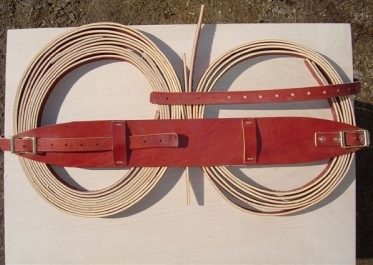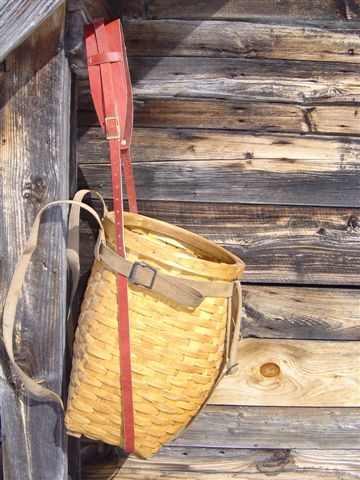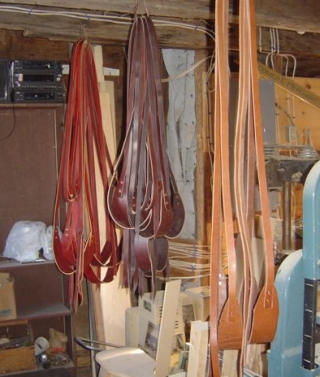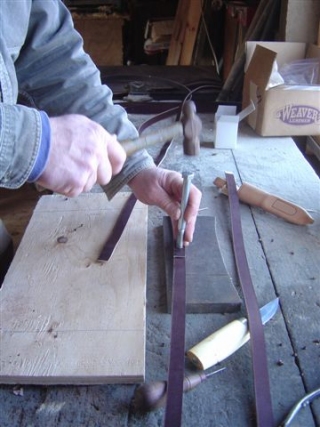Leather Tumpline
-
Tumpline
$110.00
Our tumplines are made of only the finest latigo leathers, nylon thread and copper rivets. All seams are fastened with hand pounded copper rivets and are hand-stitched to keep the lapping ends flat. Tumpline tails can be made any length you specify.
Headpiece Length: 15"
Tail length: 9' or longer
-
Canoe Tumpline
$95.00
Headpiece Lenght: 15"
Tail Length: 5' or a little longer. However long the hide was but no shorter than 5'.
-
Tumpline System
$190.00
How many tumplines do you own? How many do you want to own? The answer to the first question for most people is three. The answer to the second question is probably one.
Using a tumpline effectively requires the use of some special knots, none of which are incredibly fast to tie. On top of that, if you don't use them every day, they are incredibly easy to forget. As a result people don't like remove their tumplines once they are attached. Each packbasket, canoe, and wannigan ends up with it's own tumpline. For the average person, that's three. For an outfitter that may be a lot more.


Pole and Paddle Canoe has developed a system to save you time, money, and frustration. The system consists of a detachable headpiece, and three sets of straps. A short strap to go on a pack basket. a pair of straps to stay on your canoe, and a pair of long straps to go on your wannigan, or any other load of your choice. We can also sell you extra straps if you need them.
-
Portage Bars
$70.00
As seen in Hap Evans book Canoeing Wilderness Waters. Made from Spruce or Cypress.

A tumpline consists of two straps of material, one fastened to each side of a broader headpiece. I'd be willing to wager that the original tumpline didn't even have a headpiece. It was probably a length of cordage, rope, or hide placed on top of the head with some kind of padding in between. Could it be that one of our early ancestors needed to move a load of loose objects? Using his head, as my father used to say, for something besides a decoration, he cut a strip from around the edge of a hide, bundled the objects in what was left of the hide, tied each end of the strip to each end of the bundle, placed the strip over his head with folded piece of hair-on hide in between for padding, and walked away with it.
Tumplines today come in all kinds of configurations. The headpiece is generally from 2" to 3" wide and 15'' to 24" long. I've only seen them made from canvas or leather, but I'm sure nylon webbing would work, and in a pinch woven cordage attached to each end of this headpiece works for straps. These straps are generally 8' or longer, although some special purpose tumps are shorter; the tumps on Duluth packs come to mind. Since these tumps are made specifically to be used on the Duluth packs, the tails are shorter than 2'. The straps or tails as we call them are usually made from leather, 8 oz. - 10 oz. in thickness, and ¾" in width. I have a tump with tails made from 1" nylon strapping salvaged from a worn out drag chute from a F106 Delta Dart fighter aircraft. It has served me well. I should note that you can buy that same strapping at most hardware stores in assorted colors. Tumpline tails have been made from all kinds of cordage including string and rope.

 What is it that makes the difference between a tumpline and a good tumpline? If I had to pick one word it would be jamming, or having the knots tighten so much they're difficult to untie. Every once in awhile you get a headpiece that is top wide or too narrow or too stiff, so you cut down the width, add some padding, or add some oil. Sometimes your bundle is just the wrong size and you have to bend the tump or tie a knot right on the rivet joint, where the two piece tails are joined together. You make your bundle a little bigger or a little smaller. When you are really cursed, the knots you make in the tails jam. Make or buy a better tumpline because you'll never fix it. A note of caution; oil will only make it worse. That is why you don't see too many tumps made from string, rope, narrow nylon strap, or even wide nylon strap. Wide nylon strap will be O.K. most of the time but under a heavy enough load it will jam. Leather will also jam if you cut your tail stock too narrow, or if the leather is too light weight and therefore stretches. Rivets should be hand pounded solid copper, not those two piece metal jiffy rivets. Stitching should be kept to a minimum, perforated leather acts just like perforated paper when put under enough stress. Remember those nagging bills that say tear on the perforated line? You'll hate a torn tump even worse.
What is it that makes the difference between a tumpline and a good tumpline? If I had to pick one word it would be jamming, or having the knots tighten so much they're difficult to untie. Every once in awhile you get a headpiece that is top wide or too narrow or too stiff, so you cut down the width, add some padding, or add some oil. Sometimes your bundle is just the wrong size and you have to bend the tump or tie a knot right on the rivet joint, where the two piece tails are joined together. You make your bundle a little bigger or a little smaller. When you are really cursed, the knots you make in the tails jam. Make or buy a better tumpline because you'll never fix it. A note of caution; oil will only make it worse. That is why you don't see too many tumps made from string, rope, narrow nylon strap, or even wide nylon strap. Wide nylon strap will be O.K. most of the time but under a heavy enough load it will jam. Leather will also jam if you cut your tail stock too narrow, or if the leather is too light weight and therefore stretches. Rivets should be hand pounded solid copper, not those two piece metal jiffy rivets. Stitching should be kept to a minimum, perforated leather acts just like perforated paper when put under enough stress. Remember those nagging bills that say tear on the perforated line? You'll hate a torn tump even worse.
Look for a tumpline with a headpiece 2" to 3" wide and 15" to 24" long, with tails 8' to 12' long or longer and about ¾" wide. The whole thing should be made from the best available latigo, harness, or bridle leather in 8 oz. to 10 oz.weight. Two piece tails should be joined with and joined to the headpiece with two or three hand pounded solid copper rivets and minimal stitching, just enough to keep the joined ends from peeling back and catching on things. To find such a tump you need look no further than Pole and Paddle Canoe.

